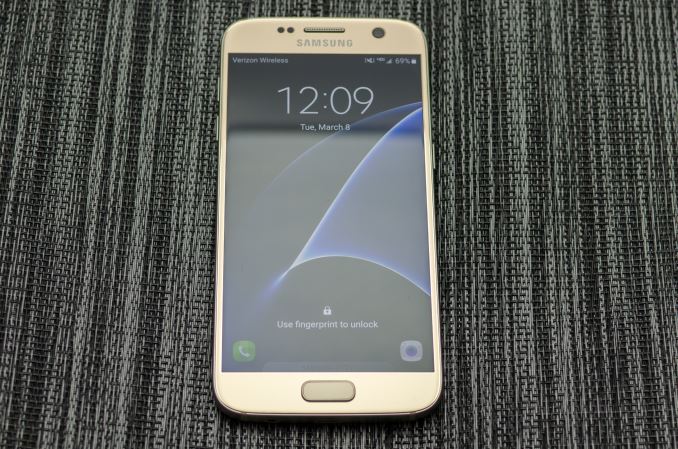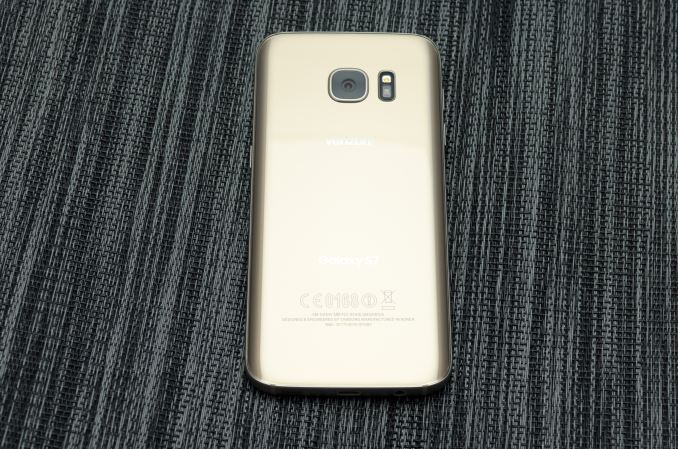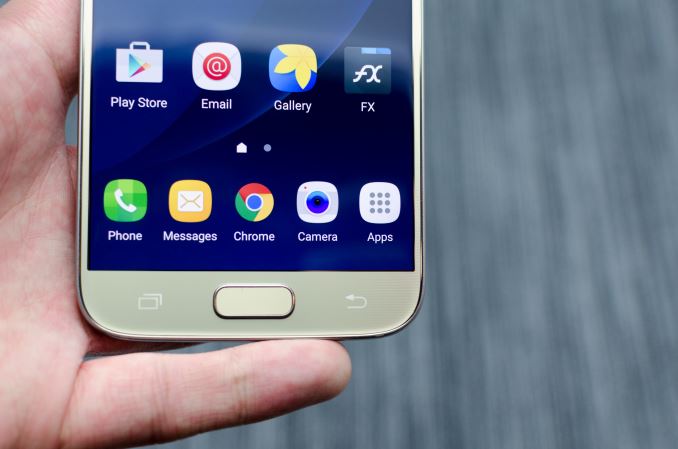The Samsung Galaxy S7 & S7 Edge Review, Part 1
by Joshua Ho on March 8, 2016 9:00 AM ESTInitial Conclusions
Even though we’re just barely scratching the surface of what we can test, the results we already have show quite a bit about the Samsung Galaxy S7. The Galaxy S line remains one of the most popular Android smartphones, and if history is any indication we can get a pretty good idea about what to expect for 2016 just by looking at the Galaxy S7 and S7 edge.
The first place we can start is design, and here we can see that the Galaxy S7 is decidedly an evolution of the Galaxy S6’s ID. However, pretty much every sharp edge has been rounded out to make the device more comfortable in the hand. The device has also been thickened in order to handle the larger battery and reduce the apparent z-height of the camera. The display size of the Galaxy S7 (non-edge) stays at 5.1 inches, and given how long Samsung has stuck to this display size it’s likely that they will be staying at this size for quite some time for their flagship.
In general, it feels like the industry has settled upon a display size somewhere between 5 to 5.5 inches for their flagship devices as going further probably won’t make a lot of sense for ergonomic reasons. I suspect Samsung and many other Android OEMs are settling into an Apple-like 2 year cadence for industrial and material design as replacement cycles lengthen, especially in the United States where subsidized phones have been almost entirely eliminated.
Meanwhile, though we haven’t had the time to run our full suite of battery life benchmarks, the data that we do have is quite interesting. At the very least, it looks like the Galaxy S7 will be a solid upgrade for those coming from the Galaxy S6 and earlier with a 15% bump in battery life or so. Anyone using a phone with an SoC not on a FinFET node will see even bigger gains to battery life, which is impressive to say the least. If you have any device with a Snapdragon 810 or 808 SoC, you’re definitely going to see major gains if you move to any device with a SoC fabricated on a FinFET node.
In terms of SoC performance, the Snapdragon 820 doesn't disappoint. In the time since testing the MDP it seems that between Qualcomm, Samsung, and Google, the trio has finally been able to optimize Snapdragon 820 for Chrome, so performance there is quite acceptable now and a pretty solid uplift over something like the Exynos 7420 or Snapdragon 810. GPU performance is also pretty much right where the Snapdragon 820 MDP was, so performance should be a good step above the A9's GT7600 GPU. Of course, we have yet to consider the power efficiency or sustainability of this performance, but turbo/overdrive performance is always relevant in the mobile space considering just how bursty almost every mobile workload is. It's pretty safe to say that Qualcomm has at least regained their footing in the SoC space, and with future SoCs they may well come to dominate the high end for performance and power once again. For now, it's looking like the race between Exynos 8890, Snapdragon 820, and Kirin 950 will be quite close.
For storage performance, to some extent it seems that the performance gains are relatively small, as the UFS 2.0 storage solutions on the Galaxy S6 and S7 are relatively similar. It’s interesting to see here that despite the now-mandatory use of FDE, the delta in performance between the Galaxy S6 and S7 in storage performance doesn’t seem to exist. This is welcome news as it wasn’t all that long ago that FDE for Android had a noticeable effect on storage performance.
On the display side, again we can see that the Galaxy S7 has a relatively similar display to the Galaxy S6. Calibration should be relatively good across the board, and AMOLED retains all of its traditional advantages including high contrast, support for wide color gamuts, low transition time, and improved power efficiency at lower average picture levels. Peak brightness is the only noticeable area where things seem to change, but I suspect that this will vary noticeably depending upon the unit. The one issue that I continue to notice here is that the edge display on the Galaxy S7 edge has a green tint at the edges, likely due to the diamond PenTile subpixel arrangement.
On the software side, Samsung’s TouchWiz UI continues to be more of the same when compared to the Galaxy Note5. The edge features continue to be somewhat interesting, but I continue to find myself thinking that there would be no difference if the same feature was implemented on the non-edge variant. Thankfully, the lag that I noticed last month in my initial hands-on time with the device seems to just have been a function of pre-release software, as the Galaxy S7 is relatively performant here. Although I’m not sure I’d go as far as to say that the Galaxy S7 is entirely free of lag. I suspect that Samsung has to balance power efficiency and responsiveness to some extent here, as while devices like the Nexus 5 can feel incredibly smooth and responsive there are very real knock-on effects in terms of practical battery life.
I’m also looking forward to testing features like Samsung Pay that are finally being deployed to the extent that I can use my personal credit card with Samsung Pay on my phone. However, out of the box TouchWiz still has some issues with an overly-neon theme, and in general things like Always-On Display already feel like they aren’t quite executed as well as they should be. I also noticed that the fingerprint scanner performance is strongly influenced by initial setup if I didn’t scan some areas on initial setup they never seemed to work very well unless I retrained the finger.
As for making a choice between the Galaxy S7 edge and Galaxy S7, there basically aren't any outside of size for the most part. There is the edge display, but by and large it feels like that's more of an aesthetic choice than a functional one. As we have seen you do get better battery life in the Galaxy S7 edge, but I don't feel like it makes sense to cross-shop the two. If you want one-handed usability, the Galaxy S7 is the only choice that makes sense. If you want a phablet, the Galaxy S7 edge is the only choice that makes sense.
Overall, I think the Galaxy S7 is looking to be one of the better devices of the year. Of course, there’s still a lot more to test, but the initial indications are already looking quite good. If you absolutely want the Galaxy S7 now, I don’t think there will be any major showstoppers present in this phone. However, if you’re looking to buy the best phone possible available this year I think it’s still too early to say where the chips will fall as Samsung's eager competitors have their own flagship phones right around the corner.














202 Comments
View All Comments
sachouba - Tuesday, March 8, 2016 - link
Thanks for this review, it's quite good.But I don't understand why the brightness would have been lowered whereas other websites tell the contrary - and Samsung usually increases the maximum brightness on every flagship device.
Moreover, the web battery life test is not representative of actual battery life, because AMOLED displays are very disadvantaged in this test on white web pages, whereas the battery life would be much higher on websites with a lot of dark areas (photos, dark background, etc.).
Some browsers allow you to use a "night mode" which inverts the colors of websites background if the APL is high.
I hope you will review the Exynos version as well - I guess it will be much smoother and with a better battery life, as always.
JoshHo - Wednesday, March 9, 2016 - link
Our new web test has some pages with dark themes currently. However, the overwhelming majority of webpages and UI have a high average picture level. In order to reflect this the vast majority of our webpages are black text on a white background.We are hoping to get an Exynos unit to compare with the Snapdragon 820.
lilmoe - Wednesday, March 9, 2016 - link
Please use the stock browser with Ad block enabled for that test on the Exynos variant. Thanks.deskjob - Tuesday, March 8, 2016 - link
I am totally for prioritizing energy efficiency and battery life over a 100% fluid UI. But I also find it hard to believe that at this stage in the smartphone evolution, a flagship device still can't achieve that goal without adverse effect on battery life. I feel like in the S7's case, it's more likely than not that Samsung and their proprietary UI is at fault for the janky UI performance. Would love it if you guys have time to investigate this further! After all, I am not sure I am not alone in saying a smooth UI is a big part of the everyday smartphone experience.heartinpiece - Tuesday, March 8, 2016 - link
Wow Finally!Will you be reviewing the Exynos 8990 as well?
Seems like a comparison between the 820 and the 8990 would be interesting!
10basetom - Tuesday, March 8, 2016 - link
I can't wait for a detailed comparison between the Snapdragon 820 and Exynos 8890 once you have both S7 models in hand.SydneyBlue120d - Wednesday, March 9, 2016 - link
Same old question, maybe in part 2 of the review we can get an answer: Is unlimited HEVC encoding at 2160p60 with both HDR and IOS supported? Thanks a lot.Osamede - Wednesday, March 9, 2016 - link
While its always interesting to see proper deep dive reviews, I find that these days there is nothing that would get me to buy another Samsung "flagship". Totally overpriced by strategically riding the slipstream of Apple's own boundless greed - except these ones do not hold value at all.s.yu - Friday, March 11, 2016 - link
You must be blind, choosing the recent iCrap over this. Apple's last good looking phone was the 5th generation.pjcamp - Wednesday, March 9, 2016 - link
You say people will find the stock Android interface "rather spartan." That strikes me as odd since I went from TouchWiz to an essentially stock Android on a Moto X Pure. I would never go back. Settings are located where they should be, not moved around at random. Customization is much easier. And stability is no longer an issue. I had, for instance, one major audiobook app that reliably crashed the system under TouchWiz to the point of needing a battery removal to get it restarted. I came to understand that TouchWiz, not the app, was the point of failure during the brief time I used Cyanogenmod and it worked fine. Also works fine on my Motorola.TouchWiz and other skins are not about operability. They are exercises in branding, equivalent to logos. Rather than being nonspartan, they are actually an impediment to usability. If you go to Google to find out how to do something, the instructions will be different from how your skinned phone operates. Sometimes it is easy to translate, sometimes not.
For a lot of people, that probably doesn't matter. But for a lot of people, introducing a skin introduces another potential point of failure, and another opportunity for vendors to point at each other in a circle should there ever be a problem.